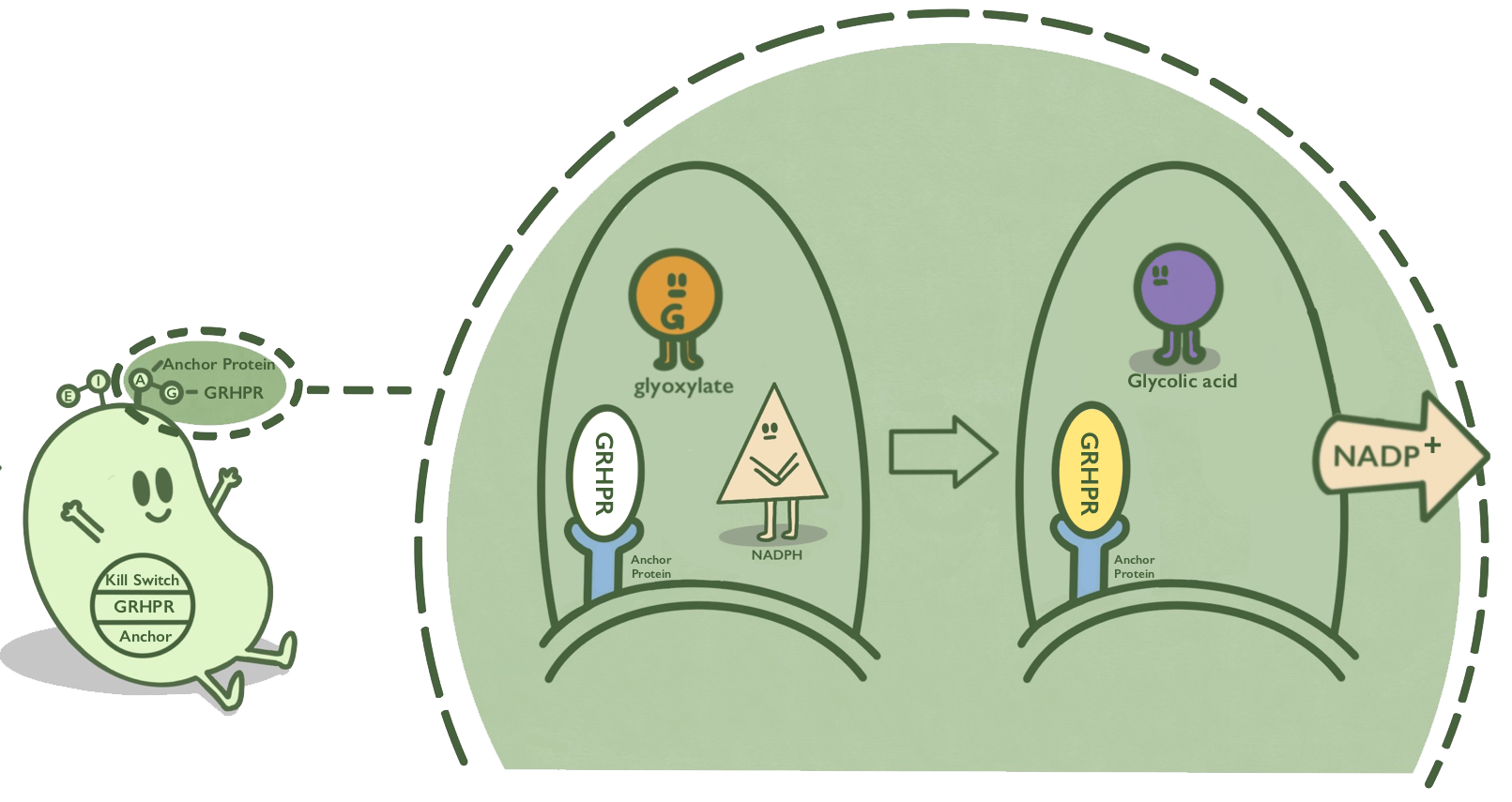Difference between revisions of "Part:BBa K3332058"
Huangzinuo (Talk | contribs) m |
|||
| Line 3: | Line 3: | ||
<partinfo>BBa_K3332058 short</partinfo> | <partinfo>BBa_K3332058 short</partinfo> | ||
| − | We anchored GRHPR protein onto membranes through Lpp-OmpA to catalyze the reaction of reducing glyoxalic acid and consuming NADPH. We use | + | We anchored GRHPR protein onto membranes through Lpp-OmpA to catalyze the reaction of reducing glyoxalic acid and consuming NADPH. We use <partinfo>BBa_K880005</partinfo> to construct the expression system and anchor GRHPR on the surface of ''E.coli''. |
| + | |||
===Biology=== | ===Biology=== | ||
| − | Lpp-OmpA is an anchor protein from E. coli, which can anchor its passenger protein to the cell membrane. It has been widely used in cell-surface display. GRHPR, a Glyoxylate reductase from human liver, can reduce glyoxylic acid when NADPH is used as cofactor. GRHPR is fused at N terminal with Lpp-OmpA so that GRHPR can be displayed on the surface of E. coli.<ref>Rumsby G, Cregeen D P. Identification and expression of a cDNA for human hydroxypyruvate/glyoxylate reductase[J]. Biochimica et Biophysica Acta (BBA) - Gene Structure and Expression, 1999, 1446(3): 383-388.</ref><ref>http://2016.igem.org/Team:TJUSLS_China</ref> | + | Lpp-OmpA is an anchor protein from ''E. coli'', which can anchor its passenger protein to the cell membrane. It has been widely used in cell-surface display. GRHPR, a Glyoxylate reductase from human liver, can reduce glyoxylic acid when NADPH is used as cofactor. GRHPR is fused at N terminal with Lpp-OmpA so that GRHPR can be displayed on the surface of ''E. coli''.<ref>Rumsby G, Cregeen D P. Identification and expression of a cDNA for human hydroxypyruvate/glyoxylate reductase[J]. Biochimica et Biophysica Acta (BBA) - Gene Structure and Expression, 1999, 1446(3): 383-388.</ref><ref>http://2016.igem.org/Team:TJUSLS_China</ref> |
<html> | <html> | ||
<figure> | <figure> | ||
| − | <img src="https://2020.igem.org/wiki/images/8/82/T--XMU-China--XMU-China_2020-GRHPR%E9%94%9A%E5%AE%9A.png" width=" | + | <img src="https://2020.igem.org/wiki/images/8/82/T--XMU-China--XMU-China_2020-GRHPR%E9%94%9A%E5%AE%9A.png" width="45%" style="float:center"> |
<figcaption> | <figcaption> | ||
<p style="font-size:1rem"> | <p style="font-size:1rem"> | ||
| Line 18: | Line 19: | ||
</html> | </html> | ||
| − | Fig 1. mechanism | + | :'''Fig 1.''' mechanism. |
| + | |||
===Usage=== | ===Usage=== | ||
| − | Here, we used | + | Here, we used <partinfo>BBa_K880005</partinfo> to construct the expression system and demonstrate the effect of Lpp-OmpA-GRHPR on the surface of ''E. coli''. We obtained the composite part <partinfo>BBa_K3332058</partinfo>. Due to the limited time, we didn’t get the gene in time. As a result, there is a lack of data about this part. The progress of this part remains in the stage of design. |
| + | |||
<html> | <html> | ||
<figure> | <figure> | ||
| − | <img src="https://2020.igem.org/wiki/images/a/aa/T--XMU-China--XMU-China_2020-J23100_B0034_lpp-ompA-grhpr_B0015.png" width=" | + | <img src="https://2020.igem.org/wiki/images/a/aa/T--XMU-China--XMU-China_2020-J23100_B0034_lpp-ompA-grhpr_B0015.png" width="45%" style="float:center"> |
<figcaption> | <figcaption> | ||
<p style="font-size:1rem"> | <p style="font-size:1rem"> | ||
| Line 33: | Line 36: | ||
</html> | </html> | ||
| − | Fig 2. Gene circuit of Lpp-OmpA-GRHPR | + | :'''Fig 2.''' Gene circuit of Lpp-OmpA-GRHPR. |
| + | |||
| + | |||
===References=== | ===References=== | ||
<references/> | <references/> | ||
| + | |||
<!-- --> | <!-- --> | ||
Latest revision as of 16:33, 27 October 2020
J23100-RBS-Lpp-OmpA-GRHPR-terminator
We anchored GRHPR protein onto membranes through Lpp-OmpA to catalyze the reaction of reducing glyoxalic acid and consuming NADPH. We use BBa_K880005 to construct the expression system and anchor GRHPR on the surface of E.coli.
Biology
Lpp-OmpA is an anchor protein from E. coli, which can anchor its passenger protein to the cell membrane. It has been widely used in cell-surface display. GRHPR, a Glyoxylate reductase from human liver, can reduce glyoxylic acid when NADPH is used as cofactor. GRHPR is fused at N terminal with Lpp-OmpA so that GRHPR can be displayed on the surface of E. coli.[1][2]

- Fig 1. mechanism.
Usage
Here, we used BBa_K880005 to construct the expression system and demonstrate the effect of Lpp-OmpA-GRHPR on the surface of E. coli. We obtained the composite part BBa_K3332058. Due to the limited time, we didn’t get the gene in time. As a result, there is a lack of data about this part. The progress of this part remains in the stage of design.

- Fig 2. Gene circuit of Lpp-OmpA-GRHPR.
References
- ↑ Rumsby G, Cregeen D P. Identification and expression of a cDNA for human hydroxypyruvate/glyoxylate reductase[J]. Biochimica et Biophysica Acta (BBA) - Gene Structure and Expression, 1999, 1446(3): 383-388.
- ↑ http://2016.igem.org/Team:TJUSLS_China
Sequence and Features
- 10COMPATIBLE WITH RFC[10]
- 12INCOMPATIBLE WITH RFC[12]Illegal NheI site found at 7
Illegal NheI site found at 30 - 21COMPATIBLE WITH RFC[21]
- 23COMPATIBLE WITH RFC[23]
- 25INCOMPATIBLE WITH RFC[25]Illegal AgeI site found at 1073
- 1000COMPATIBLE WITH RFC[1000]
